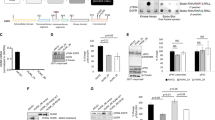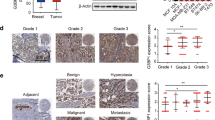Abstract
Understanding the mechanisms underlying ErbB3 overexpression in breast cancer will facilitate the rational design of therapies to disrupt ErbB2-ErbB3 oncogenic function. Although ErbB3 overexpression is frequently observed in breast cancer, the factors mediating its aberrant expression are poorly understood. In particular, the ErbB3 gene is not significantly amplified, raising the question as to how ErbB3 overexpression is achieved. In this study we showed that the ZNF217 transcription factor, amplified at 20q13 in ∼20% of breast tumors, regulates ErbB3 expression. Analysis of a panel of human breast cancer cell lines (n=50) and primary human breast tumors (n=15) showed a strong positive correlation between ZNF217 and ErbB3 expression. Ectopic expression of ZNF217 in human mammary epithelial cells induced ErbB3 expression, whereas ZNF217 silencing in breast cancer cells resulted in decreased ErbB3 expression. Although ZNF217 has previously been linked with transcriptional repression because of its close association with C-terminal-binding protein (CtBP)1/2 repressor complexes, our results show that ZNF217 also activates gene expression. We showed that ZNF217 recruitment to the ErbB3 promoter is CtBP1/2-independent and that ZNF217 and CtBP1/2 have opposite roles in regulating ErbB3 expression. In addition, we identify ErbB3 as one of the mechanisms by which ZNF217 augments PI-3K/Akt signaling.
This is a preview of subscription content, access via your institution
Access options
Subscribe to this journal
Receive 50 print issues and online access
$259.00 per year
only $5.18 per issue
Buy this article
- Purchase on Springer Link
- Instant access to full article PDF
Prices may be subject to local taxes which are calculated during checkout







Similar content being viewed by others
References
Agus D, Akita R, Fox W, Lewis G, Higgins B, Pisacane P et al. (2002). Targeting ligand-activated ErbB2 signaling inhibits breast and prostate tumor growth. Cancer Cell 2: 127–137.
Chin K, DeVries S, Fridlyand J, Spellman PT, Roydasgupta R, Kuo WL et al. (2006). Genomic and transcriptional aberrations linked to breast cancer pathophysiologies. Cancer Cell 10: 529–541.
Chinnadurai D . (2007). Transcriptional regulation by C-terminal binding proteins. Int J Biochem Cell Biol 39: 1593–1607.
Chinnadurai D . (2009). The transcriptional corepressor CtBP: a foe of multiple tumor suppressors. Cancer Res 69: 731–734.
Collins C, Rommens JM, Kowbel D, Godfrey T, Tanner M, Hwang SI et al. (1998). Positional cloning of ZNF217 and NABC1: genes amplified at 20q13.2 and overexpressed in breast carcinoma. Proc Natl Acad Sci USA 95: 8703–8708.
CoreTeam R-D (2006). R: A Language and Environment for Statistical Computing. R Foundation for Statistical Computing: Vienna, Austria.
Cowger JJ, Zhao Q, Isovic M, Torchia J . (2007). Biochemical characterization of the zinc-finger protein 217 transcriptional repressor complex: identification of a ZNF217 consensus recognition sequence. Oncogene 26: 3378–3386.
Engelman JA, Zejnullahu K, Mitsudomi T, Song Y, Hyland C, Park JO et al. (2007). MET amplification leads to gefitinib resistance in lung cancer by activating ERBB3 signaling. Science 316: 1039–1043.
Folgiero V, Avetrani P, Bon G, Di Carlo SE, Fabi A, Nistico C et al. (2008). Induction of ErbB-3 expression by alpha6beta4 integrin contributes to tamoxifen resistance in ERbeta1-negative breast carcinomas. PLoS One 3: e1592.
Folgiero V, Bachelder RE, Bon G, Sacchi A, Falcioni R, Mercurio AM . (2007). The alpha6beta4 integrin can regulate ErbB-3 expression: implications for alpha6beta4 signaling and function. Cancer Res 67: 1645–1652.
Frank D . (2009). Targeting transcription factors for cancer therapy. Drugs 12: 29–33.
Guy PM, Platko JV, Cantley LC, Cerione RA, Carraway III K . (1994). Insect cell-expressed p180erbB3 possesses an impaired tyrosine kinase activity. Proc Natl Acad Sci USA 91: 8132–8136.
Heidenreich O . (2009). Targeting oncogenes with siRNAs. Methods Mol Biol 487: 221–242.
Hildebrand JD, Soriano P . (2002). Overlapping and unique roles for C-terminal binding protein 1 (CtBP1) and CtBP1 during mouse development. Mol Cell Biol 22: 5296–5307.
Holbro T, Beerli R, Maurer F, Koziczak M, Barbas III CF, Hynes N . (2003). The ErbB2/ErbB3 heterodimer functions as an oncogenic unit: ErbB2 requires ErbB3 to drive breast tumor cell proliferation. Proc Natl Acad Sci USA 100: 8933–8938.
Huang G, Krig S, Kowbel D, Xu H, Hyun B, Volik S et al. (2005). ZNF217 suppresses cell death associated with chemotherapy and telomere dysfunction. Human Mol Genetics 14: 3219–3225.
Iwabuchi H, Sakamoto M, Sakunaga H, Ma YY, Carcangiu ML, Pinkel D et al. (1995). Genetic analysis of benign, low-grade, and high-grade ovarian tumors. Cancer Res 55: 6172–6180.
Junttila TT, Akita RW, Parsons K, Fields C, Lewis PG, Friedman LS et al. (2009). Ligand-independent HER2/HER3/PI3 K complex is disrupted by trastuzumab and is effectively inhibited by the PI3 K inhibitor GDC-0941. Cancer Cell 15: 429–440.
Kallioniemi A, Kallioniemi OP, Piper J, Tanner M, Stokke T, Chen L et al. (1994). Detection and mapping of amplified DNA sequences in breast cancer by comparative genomic hybridization. Proc Natl Acad Sci USA 91: 2156–2160.
Krig SR, Jin VX, Bieda MC, O'Geen H, Yaswen P, Green R et al. (2007). Identification of genes directly regulated by the oncogene ZNF217 using chromatin immunoprecipitation (ChIP)-chip assays. J Biol Chem 282: 9703–9712.
Lee J, Engelman J, Cantley L . (2007). Biochemistry. PI3K charges ahead. Science 317: 239–242.
Li P, Maines-Bandiera S, Kuo WL, Guan Y, Sun Y, Hills M et al. (2007). Multiple roles of the candidate oncogene ZNF217 in ovarian epithelial neoplastic progression. Int J Cancer 120: 1863–1873.
Liu B, Ordonez-Ercan D, Fan Z, Edgerton SM, Yang X, AD T . (2007). Downregulation of erbB3 abrogates erbB2-mediated tamoxifen resistance in breast cancer cells. Int J Cancer 120: 1874–1882.
Martin C, Zhang Y . (2005). The diverse functions of lysine methylation. Nature Rev Mol Cell Biol 6: 838–849.
Nonet GH, Stampfer MR, Chin K, Gray JW, Collins CC, Yaswen P . (2001). The ZNF217 gene amplified in breast cancers promotes immortalization of human mammary epithelial cells. Cancer Res 61: 1250–1254.
O'Geen H, Nicolet CM, Blahnik K, Green R, Farnham PJ . (2006). Comparison of sample preparation methods for ChIP-chip assays. Biotechniques 41: 577–580.
Plowright L, Harrington K, Pandha H, Morgan R . (2009). HOX transcription factors are potential therapeutic targets in non-small-cell lung cancer (targeting HOX genes in lung cancer). Br J Cancer 100: 470–475.
Quinlan KG, Nardini M, Verger A, Francescato P, Yaswen P, Corda D et al. (2006). Specific recognition of ZNF217 and other zinc finger proteins at a surface groove of C-terminal binding proteins. Mol Cell Biol 26: 8159–8172.
Sassen A, Rochon J, Wild P, Hartmann A, Hofstaedter F, Schwarz S et al. (2008). Cytogenetic analysis of HER1/EGFR, HER2, HER3 and HER4 in 278 breast cancer patients. Breast Cancer Res 10: R2.
Schlegel J, Stumm G, Scherthan H, Bocker T, Zirngibl H, Ruschoff J et al. (1995). Comparative genomic in situ hybridization of colon carcinomas with replication error. Cancer Res 55: 6002–6005.
Sergina NV, Rausch M, Wang D, Blair J, Hann B, Shokat KM et al. (2007). Escape from HER-family tyrosine kinase inhibitor therapy by the kinase-inactive HER3. Nature 445: 437–441.
Shakya A, Cooksey R, Cox J, Wang V, McClain D, Tantin D . (2009). Oct1 loss of function induces a coordinate metabolic shift that opposes tumorigenicity. Nat Cell Biol 11: 320–327.
Shi F, Telesco SE, Liu Y, Radhakrishnan R, Lemmon MA . (2010). ErbB3/HER3 intracellular domain is competent to bind ATP and catalyze autophosphorylation. Proc Natl Acad Sci 107: 7692–7697.
Shi Y, Sawada J, Sui G, Affar el B, Whetstine JR, Lan F et al. (2003). Coordinated histone modifications mediated by a CtBP co-repressor complex. Nature 422: 735–738.
Shi YJ, Matson C, Lan F, Iwase S, Baba T, Shi Y . (2005). Regulation of LSD1 histone demethylase activity by its associated factors. Mol Cell 19: 857–864.
Siegel PM, Ryan ED, Cardiff RD, Muller WJ . (1999). Elevated expression of activated forms of Neu/ErbB-2 and ErbB-3 are involved in the induction of mammary tumors in transgenic mice: implications for human breast cancer. Embo J 18: 2149–2164.
Singh A, Boldin-Adamsky S, Thimmulappa R, Rath S, Ashush H, Coulter J et al. (2008). RNAi-mediated silencing of nuclear factor erythroid-2-related factor 2 gene expression in non-small cell lung cancer inhibits tumor growth and increases efficacy of chemotherapy. Cancer Res 68: 7975–7984.
Sithanandam G, Anderson LM . (2008). The ERBB3 receptor in cancer and cancer gene therapy. Cancer Gene Ther 15: 413–448.
Solinas-Toldo S, Wallrapp C, Muller-Pillasch F, Bentz M, Gress T, Lichter P . (1996). Mapping of chromosomal imbalances in pancreatic carcinoma by comparative genomic hybridization. Cancer Res 56: 3803–3807.
Tanner MM, Tirkkonen M, Kallioniemi A, Holli K, Collins C, Kowbel D et al. (1995). Amplification of chromosomal region 20q13 in invasive breast cancer: prognostic implications. Clin Cancer Res 1: 1455–1461.
Thillainadesan G, Isovic M, Loney E, Andrews J, Tini M, Torchia J . (2008). Genome analysis identifies the p15ink4b tumor suppressor as a direct target of the ZNF217/CoREST complex. Mol Cell Biol 28: 6066–6077.
Ursini-Siegel J, Schade B, Cardiff RD, Muller WJ . (2007). Insights from transgenic mouse models of ERBB2-induced breast cancer. Nat Rev Cancer 7: 389–397.
Wang SE, Xiang B, Guix M, Olivares MG, Parker J, Chung CH et al. (2008). Transforming growth factor beta engages TACE and ErbB3 to activate phosphatidylinositol-3 kinase/Akt in ErbB2-overexpressing breast cancer and desensitizes cells to trastuzumab. Mol Cell Biol 28: 5605–5620.
Xue C, Liang F, Mahmood R, Vuolo M, Wyckoff J, Qian H et al. (2006). ErbB3-dependent motility and intravasation in breast cancer metastasis. Cancer Res 66: 1418–1426.
Yen L, Cao Z, Wu X, Ingalla ER, Baron C, Young LJ et al. (2006). Loss of Nrdp1 enhances ErbB2/ErbB3-dependent breast tumor cell growth. Cancer Res 66: 11279–11286.
Zhou BB, Peyton M, He B, Liu C, Girard L, Caudler E et al. (2006). Targeting ADAM-mediated ligand cleavage to inhibit HER3 and EGFR pathways in non-small cell lung cancer. Cancer Cell 10: 39–50.
Acknowledgements
This work was supported by NIH grant R01 CA118384 (CS); NIH grant RO1 CA45250 (PJF); U54 CA112970 (PY, RN), and the Office of Energy Research, Office of Health and Biological Research, US Department of Energy under Contract No. DE-AC03-76SF00098 (PY) and NIH Center for Research Resources (NCRR) UL1 RR024146 (LAB). JM was a recipient of a DOD Breast Cancer Research Program Predoctoral fellowship: W81XWH-06-1-0402. We thank Dr Nelly Auersperg (U Vancouver) for the recombinant adenoviral ZNF217 construct and Jeremy Semeiks for his assistance with the adenoviral transduction experiments. We thank Dr Jeffrey Hildebrand for the CtBP2-null mef-90 fibroblasts and Dr Merlin Crossly for the CtBP2_pcDNA_3.1 expression construct. We thank Dr Hongwu Chen for the pCmX vector, Dr James Trimmer for the co-REST ascites and Dr Martha Stampfer for the HMEC 184 cells. CTCS statistical support is made possible by Grant Number UL1 RR024146 from the Center for Research Resources (NCRR), a component of the National Institutes of Health (NIH), and NIH Roadmap for Medical Research. A special thank you to members of the Farnham lab for valuable discussions.
Author information
Authors and Affiliations
Corresponding authors
Ethics declarations
Competing interests
The authors declare no conflict of interest.
Additional information
Supplementary Information accompanies the paper on the Oncogene website
Rights and permissions
About this article
Cite this article
Krig, S., Miller, J., Frietze, S. et al. ZNF217, a candidate breast cancer oncogene amplified at 20q13, regulates expression of the ErbB3 receptor tyrosine kinase in breast cancer cells. Oncogene 29, 5500–5510 (2010). https://doi.org/10.1038/onc.2010.289
Received:
Revised:
Accepted:
Published:
Issue Date:
DOI: https://doi.org/10.1038/onc.2010.289
Keywords
This article is cited by
-
Dimethyl fumarate inhibits ZNF217 and can be beneficial in a subset of estrogen receptor positive breast cancers
Breast Cancer Research and Treatment (2023)
-
MicroRNA-708 targeting ZNF549 regulates colon adenocarcinoma development through PI3K/AKt pathway
Scientific Reports (2020)
-
Stochastic changes in gene expression promote chaotic dysregulation of homeostasis in clonal breast tumors
Communications Biology (2019)
-
ErbB3 upregulation by the HNSCC 3D microenvironment modulates cell survival and growth
Oncogene (2016)
-
Impact of non-neoplastic vs intratumoural hepatitis B viral DNA and replication on hepatocellular carcinoma recurrence
British Journal of Cancer (2016)



